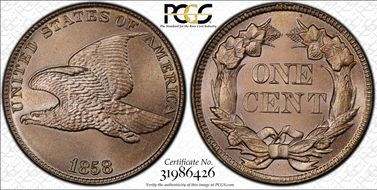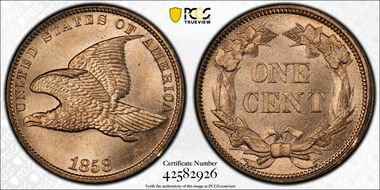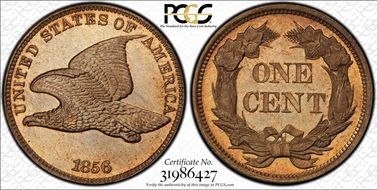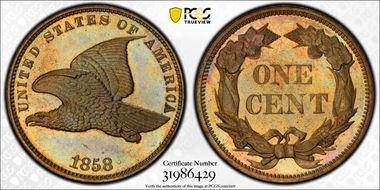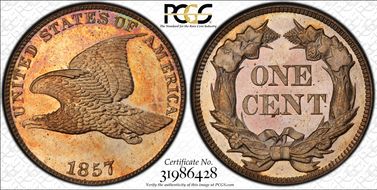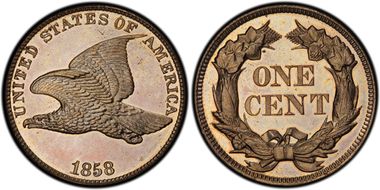Foreside 的钱币相册
Words fall short of describing this incredibly preserved CAC certified gem that displays lovely rose gold hues over unabraded satin surfaces. The clarity of the strike on both sides rivals perfection and the sheer eye appeal is overwhelming. Premium Gem Large Letter coins are extremely rare, and there are no finer one known. The PCGS grade MS67+, pop 1 of 1, is highest known MS grade Flying Eagle for ANY year. An absolutely marvelous coin that currently resides in the Foreside Collection on the PCGS Registry.
This Plus-graded Premium Gem has CAC endorsement and is tied for finest,. It currently resides in the famous Foreside Collection. The 1858 Small Letters variant with low leaves on the reverse, is technically a one-year design type, although it is not always collected as such. The 1858 mintage was about evenly with the Large Letters variant, from a total mintage of more than 24 million pieces. Both the Small Letters and Large Letters types are scarce in Gem or finer grades.. Smooth and lustrous reddish-gold surfaces offer great eye appeal, enhanced by a needle-sharp strike. A true gem.
True 1856 Proof gems are rare, and this fabulous specimen is a strong contender for the finest known with serious “+” potential. Exhibiting a needle-sharp strike and amazingly pristine surfaces, this lovely cent has a beauty and naturalness to it lacking in most of the surviving examples. Both sides are evenly toned to a charming honey-mustard color, with a hint of rich magenta around the reverse boarder. A stunning, understated coin.
CAC Cerified. Snow PR2. A Small Letters obverse paired with a Low Leaves reverse. Snow describes the main reverse diagnostic as a "diagonal die line in denticles below the right ribbon end." This is plain on the present piece once on knows where to look. This is a remarkable Premium Gem specimen that makes a wonderful first impression. Bright lemon-gold and orange fields show subtle blue-green accents, and the mildly frosted devices stand out from the mirrors. On closer inspection, a few tiny flyspecks (such as the one below the claw) and contact marks are visible, but their influence on the eye appeal is minimal. This coin clearly should be designated Cameo.
This is a lovely Gem, PCGS MS65, CAC Certified, 1858/7 Strong S-7 cent, with a bold to sharp strike and satiny golden-orange luster. Snow-7 was discovered by Mark McWherter and announced in a front-page article in Numismatic News on September 12, 1995. According to Rick Snow in the third edition of The Flying Eagle & Indian Cent Attribution Guide, Volume 1: 1856-1877, only 25 or so examples have been confirmed since that time. The finest specimen known to the author is an MS-65, presumably the only other example attributed and graded as such by PCGS. This coin is a newcomer to the Condition Census for this variety. Snow-7 is often confused with the more famous 1858/7 Flying Eagle cent variety attributed as Snow-1. Unlike that variety, however, Snow-7 is unknown in different die states; all known examples display faint remnants of the upper right corner of a digit 7 to the right of the final digit 8 in the date. A loupe also reveals remnants of the flag of a 1 to the left of the primary digit. This variety is also a Doubled Die Obverse with doubling to the letters UNITE in UNITED along the left border. PCGS Population (Snow-7 attribution only): 2; 0 finer.
The mintage of proof 1857 Flying Eagle cents has traditionally been estimated at 485 pieces, but Richard Snow believes the true production total was approximately 50 examples, making this date one of the most challenging of the series. Proofs in Gem condition are very rare today, and only two coins has been certified by PCGS in higher numeric grade. The present CAC Certified coin is a stunning Gem, with reflective red surfaces, accented by wisps of lavender. The extraordinary strike imparts fine detail to all design elements, and the fields show only the most inconsequential flaws without a loupe. A truly magnificent coin.
1858 1C PCGS Large Letters PR66+ Cameo, CAC Certified, is finest known 1 of 1. Occasionally prooflike Flying Eagle cents are confused with the very rare proof strikings, but in this case there can be no confusion. The diagnostics for genuine proofs are listed in Snow's book that covers this series. That include diagonal die file marks in the denticles below the first 8 and the 5 in the date, the date slants up to the right, and minor doubling is also seen on UNI in UNITED. As with all genuine proof Flying Eagle cents, the fields are deeply mirrored and the striking definition is razor sharp. This coin is truly a wonder to behold. The fields show unfathomable depth of reflectivity and the devices are nicely frosted, which yields an unmistakable two-toned cameo effect. The surfaces are hairline-free and we cannot locate any specks of carbon. Only 100 Large Letter proofs are estimated to have been struck. This number is based upon a known production of 80 silver proof sets plus a small number of pattern sets, probably no more than 20 pieces. Snow believes no more than 50 examples survive today in all grades, a number that would make an original mintage of 100 pieces seem like a reasonable estimate. This is the finest example certified by PCGS and it is essentially an unimprovable coin. The pristine surfaces retain a generous amount of original whitish color from the copper-nickel alloy with the addition of a light overlay of pale reddish patina on each side. A magnificent gem that currently resides in the Foreside collection on the PCGS Registry.
1856 1C MS65 PCGS. CAC Certified, Snow-3. Die Stage A. Ex: Joshua and Ally Walsh. The obverse die of this variety is easily identifiable by repunching on the 5 in the date. This die was also used to strike coins of the Snow-1 and Snow-10 varieties. The most evident reverse diagnostics are the high leaves at the C and T in CENT. This reverse die was also used to strike Snow-8. According to Snow (2001), examples of Snow-3 are the second most frequently encountered 1856 Flying Eagle cents in today's market. This die pair was used from 1856 through early 1857. The first coins produced were copper die trial pieces (Judd-281, Pollock-213), of which only two examples are accounted for today. The Mint then struck 634-800 business strike 1856 Flying Eagle cents of the Snow-3 die marriage using copper-nickel planchets. Snow asserts that these coins were prepared for two purposes: to test the press and dies in a simulated business strike run, and to provide examples of the proposed copper-nickel cent to members of Congress. The first copper-nickel examples of Snow-3 that emerged from the dies are prooflike in finish with moderately reflective mirrors in the fields. These coins are known as Die Stage A, and they can be easily mistaken for proofs by collectors who are not aware of the other diagnostics for Snow-3. All examples of this variety lack the completeness of strike that proof 1856 Flying Eagle cents display. The present coin, while certainly sharp in overall detail, exhibits a little softness of strike over the eagle's breast feathers. In addition, the reverse devices, particularly the cotton leaves in the wreath, have rounded edges. As befits the die stage, this coin displays moderately reflective fields. The color is a warm, original, honey-gold shade with swirls of medium tan and lilac patina here and there. Both sides are free of bothersome handling marks, although a tiny carbon fleck in the obverse field above the date is noted. Truly, truly, a remarkable gem!
CAC and Photo Seal designation. Absolutely superb Gem Unc (15:5,5,5). This is the single finest known 1857 Flyin Eagle cent. It is also the prized Snow-1 and a beautiful proof like example. The Snow-1 is the obverse style of 1856 with a bold repunched date. It is believed to be struck from the first die pair used in 1857. The coin is listed in the PCGS population under both the regular date (PCGS #2016) and the variety number (PCGS #410433).




















